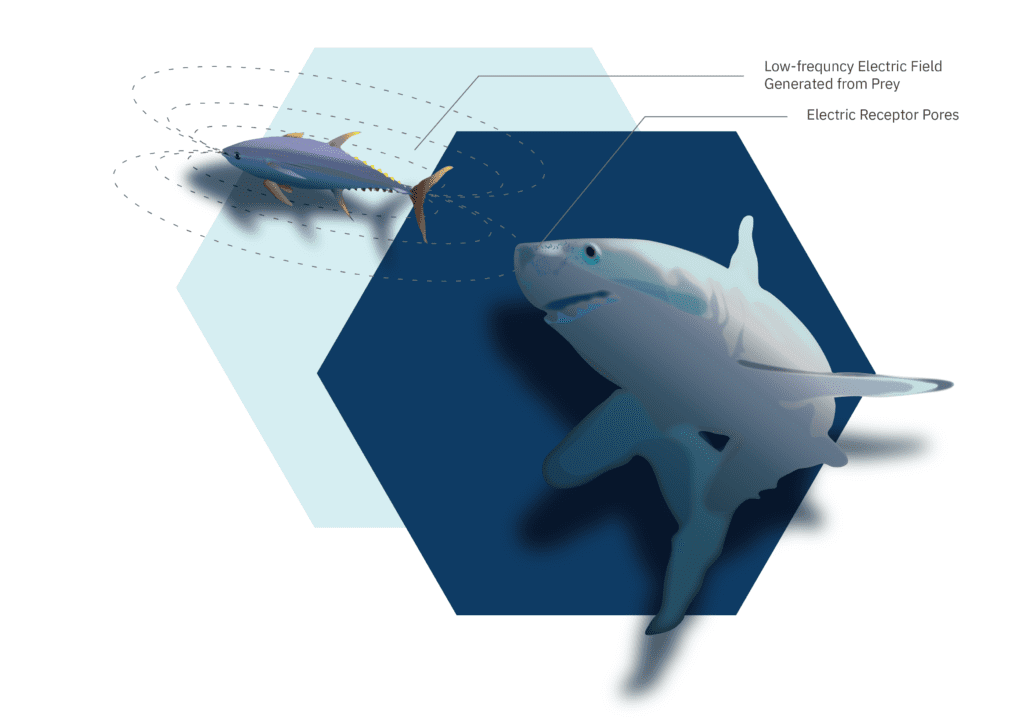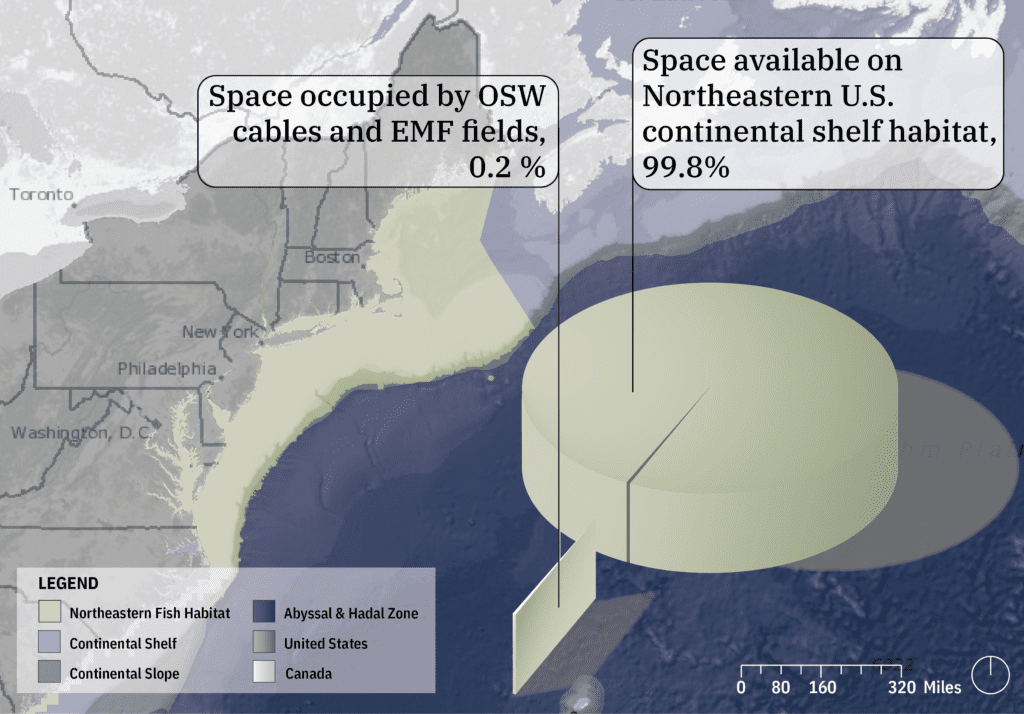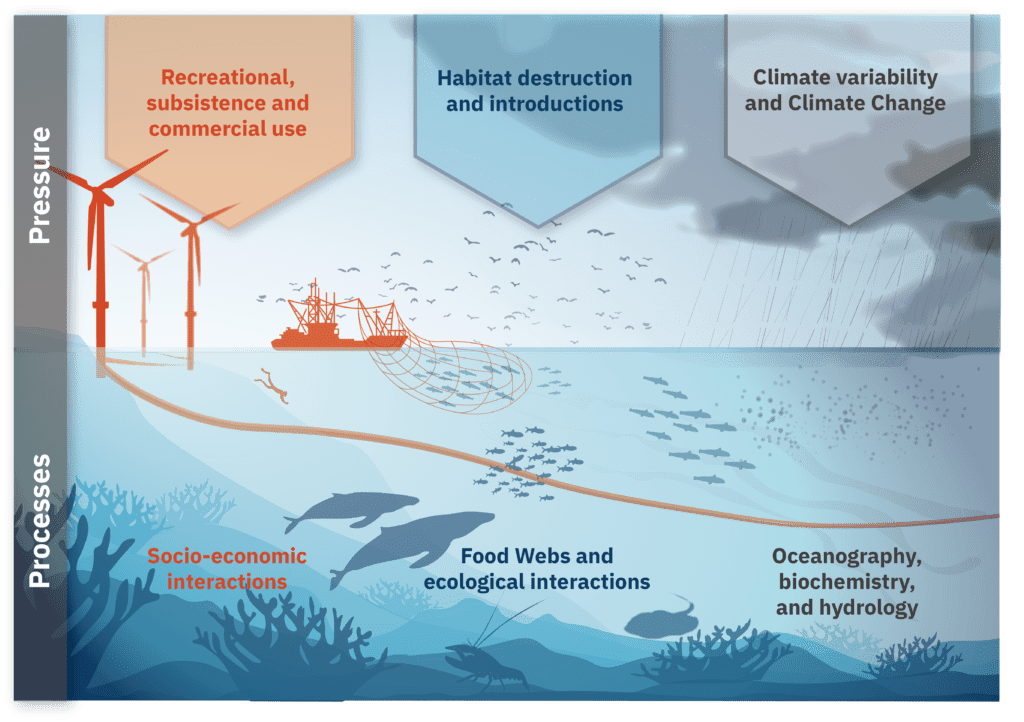EMF Risks from Offshore Wind: A Complete Understanding
By Damian V. Preziosi, Managing Principal, Strategic Initiatives Director
All electrical conductors generate electric and magnetic fields (EMF), and submarine cables carrying electricity from offshore wind (OSW) farms are no different. This category of conductors includes cables at the base of wind turbines, buried inter-array cables connecting the turbines, cables at the foundations of offshore substations, and cables used to export electricity to land. All generate EMF in the surrounding ecosystem.
For those interested in pursuing OSW development, the possibility of these fields affecting the marine ecosystem can be a daunting thought.
The existence of EMF in the marine environment is nothing new, however. Earth’s geomagnetic field extends throughout the oceans, and man-made sources of these fields such as bridges, ships, certain kinds of pipelines, and submarine cables used for telecommunications and electrical transmission are already widespread. Unlike Earth’s ubiquitous geomagnetic field, EMF from subsea cables dissipates quickly, usually to near background levels.
So, what is there to be concerned about?
Studies have shown that a variety of marine organisms have evolved highly specialized sensory systems capable of detecting certain kinds of EMF. Researchers hypothesize that adding anthropogenic EMF to the marine environment could interfere with this reception of electrical and magnetic signals and perhaps interfere with ordinary responses to the signals by marine life. These marine organisms include crabs, lobsters, sharks, skates, salmon, sturgeon, and sea turtles. For example, sharks use the electric receptor pores around their mouths to detect extremely low frequency fields generated by prey. Meanwhile, turtles rely on the Earth’s geomagnetic field for navigating across vast ocean expanses.
Herein lies the crux of the problem. The last 40 years of research confirm that certain marine species can not only detect, but can also respond to EMF, including those from submarine cables. Such responses are behavioral, such as avoiding cables, resting, or exhibiting different patterns of swimming.
There are concerns that the kind of behavioral responses observed can lead to harmful effects to individual organisms, creating a domino effect that could impact whole populations of species and, eventually, vast, complex ocean food webs. However, the line between an animal responding to EMF and it causing them harm is unclear, which is why it is important not to react by immediately exercising the precautionary principle—that is, because the effect is unknown, all matter of caution should be taken and thus no level of EMF should be permitted. Doing so might not be in nature’s best interest, as the price of forgoing our efforts into diversifying our energy sources poses a far more significant threat to the natural world.
What can be done to better inform the understanding of the potential for effects?
Fortunately, there is already a robust framework ecologists have at their ready disposal: the ecological risk assessment (ERA) framework. Introduced in the 1980s and more formally developed by the U.S. Environmental Protection Agency in the 1990s¹, it has been of tremendous use in assessing risks posed by chemical contaminants such as mercury, PCBs, and pesticides, and proves just as useful for assessing physical stressors, such as noise, light, and, most importantly, EMF.
Generally, there are two requirements that need to be met to determine risk. First, the organism must be present where a stressor is present, and second, the stressor must be present at a level suspected to cause harmful effects. If both conditions are not met, then the potential for risk is deemed low, or de minimis. ERA helps ecologists describe and map out these conditions while also identifying what types of new information should be obtained to continually inform the understanding of these conditions and risks. In simple terms, ERA is a process that helps in connecting dots.
Using ERA, we applied some straightforward approaches to improve the understanding and communication of EMF risks for OSW projects. Here are a few conclusions we reached.
1. Better accounting of the spatial extent of EMF from OSW is necessary.
By addressing spatial scale, we can better guide the protection of entire populations of species, as is done normally for ecosystem-based management of U.S. fisheries.
Case in point: many people are surprised to hear that OSW subsea cables are only about 15–25 cm in diameter. When adding up all cables for an OSW project, and a buffer of a few meters to account for EMF, the total area actually represents only a small fraction of the offshore ecosystem.
Hypothetically, only a small proportion of populations can be exposed to EMF, and not necessarily at levels sufficient to cause harm.
With this understanding, future efforts can include consolidating individual export cables into a single offshore grid before final routing toward landfall, which could be a significant move in mitigating cumulative EMF effects across multiple OSW projects.
2. Plenty of data from field and laboratory studies on the effects of EMF are already in hand. Now, it’s time to optimize use of these data to model risks to marine populations and food webs.
For decades, ecologists have relied on fisheries models to work toward ecosystem-based management of sustainable fisheries. These models account for the biomass and energy of a vast array of marine species living in dynamic and interdependent food webs. Such models can be easily adapted to include information about potential behavioral changes that may occur from a species’ exposure to EMF. Certain models of this kind can also be broadened to include fishing pressure, climate change, changes in habitat, and economics.
We used an off-the-shelf model developed for the Northeast U.S. (NEUS) Continental Shelf Ecosystem and adapted parameters to model hypothetical behavioral changes to little skate (Leucoraja erinacea) and American lobster (Homarus americanus) from EMF exposure. This included modeling small (project area), medium (southern New England), and large (NEUS Continental Shelf Ecosystem) areas to factor for different populations. Results showed that behavioral changes are unlikely to affect the health of any individual, population, or food web.
The application of the ERA framework illuminates information gathering needs in several areas. First, there is a need to reconcile the levels of EMF known to cause harmful effects at both the individual organism and population levels. Second, there is a need to evaluate dose-response, which means evaluating whether an increase in harmful effects correlates with increasing levels of EMF, whether those effects plateau, or whether there are even situations where beneficial effects occur.
Although here we discuss the benefits for understanding the effects of EMF, the ERA also can be used to evaluate OSW marine noise, habitat effects, and bird and bat encounters. As the U.S. and individual states move forward with increased urgency toward energy transition and making OSW a reality, we see a greater need for conformity in adopting the ERA framework to ensure that stakeholders are able to proceed with actionable insights and the confidence that they are acting in nature’s best interests. A wide array of stressors beyond just EMF can be evaluated under the ERA framework, creating a systematic and science-based approach to “doing OSW right the first time.”






